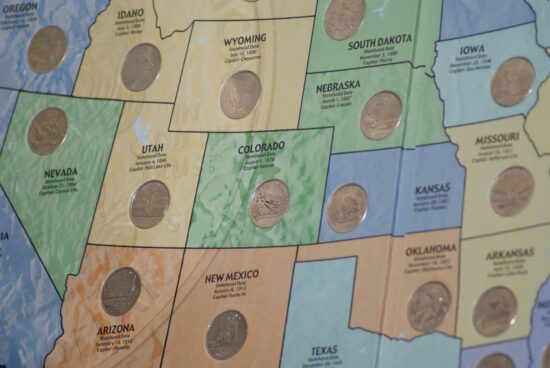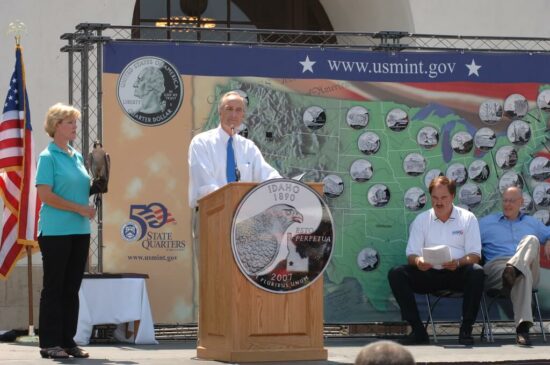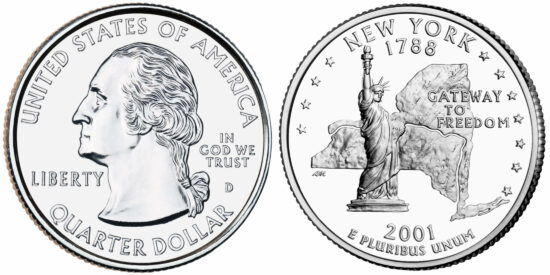When the 50 State Quarters programme ended in 2008, the US Mint’s overall assessment of the project was very positive. According to the mint, the coin series had been the most successful programme in the mint’s history and had become a nationwide phenomenon. Media coverage and the perception by the public had been great, a whole new generation had become addicted to coin collecting. And also from the financial point of view it had been very good business for the US Mint. So, what was so revolutionary about this series and made it become such a success?
Finally Something New
The first 50 State Quarters were launched 23 years ago, in 1999. At the time, they were something special due to the mere fact that the motif on American circulation coins changed for the first time since the 200th anniversary of the United States in 1976. Since the 1930s, the quarter had depicted George Washington on the obverse and an eagle on the reverse – not very exciting. Something new was needed. Of course, George Washington remained in his traditional place. But the eagle on the reverse was replaced with a completely new idea: instead of a single motif, many different images would circulate. This made the pieces look like commemorative coins although they were circulation money.
Which motifs were chosen? Each of the 50 US states was given an own coin motif. The inspiration for this concept came from Canada. There, a series of 12 commemorative coins of 25 cents had been issued in 1992 to celebrate the 125th anniversary of the Canadian Confederation, giving one coin to each of Canada’s 12 provinces and territories.
The US programme was much larger: for 10 years, 5 different quarter coins were issued every year. Each coin was only minted for 10 weeks. The federal states were dealt with in the order in which they had ratified the US Constitution: 1999 started with Delaware (admitted to the US in 1787) and the last coin of 2008 was dedicated to Hawaii (a federal state since 1959).
The programme pursued several goals. For one, it had a teaching mission with regard to politics. Americans, old and especially young, should see the diversity of their country and the individuality of their states. And, something even more important: the mint wanted to rekindle enthusiasm for coin collecting. To this end, they wisely recalled why coin collecting was so fascinating in the first place: finding treasures for your collection in your change. They wanted to instil a love of coins – particularly in children –, while allowing them to learn something about their country at the same time.
Since the quarters themselves aren’t worth much, the idea was to enable young collectors to find them in their change, too, without having to put aside most of their pocket money. After all, a complete collection of all 50 quarters only had a face value of 12.50 dollars. On a collector map, the coins could then be placed in accordingly shaped gaps in the place of the respective federal state. Alternatively, the Grandparents could invest in a small album for their grandchildren, which also contained more information about the states. The US Mint also provided teaching material for schools, which was downloaded millions of times from the mint’s website although the internet was still quite new at the time – so the programme’s educational mission was certainly accomplished!
Those who pursued coin collecting a little more extensively or with a higher budget could also try to get hold of one specimen of each coin from Denver and one from Philadelphia since both mints produced the coins. Moreover, there were proof and silver versions created by the San Francisco Mint.
Present Your State
Which motifs were depicted on 50 State Quarters? Every coin bears the name of the respective state and the year in which it joined the US. In addition there is the year of issue and the national motto of the US, which perfectly fits this series: e pluribus unum – out of many, one. Everything else was left to the states. They could decide on their own how “their” coin was to look like – within a certain framework.
This was another smart idea. Choosing a motif to represent the state became an important image-building issue. What was the best way to show the rest of the country that your own state was special? Most states followed a multi-step approach to find their motif. The public could submit proposals that were collected by the governor. After a preliminary selection and the approval of the US Mint, the final choice was made – either by the governor or by popular vote. The process was usually covered by many media outlets and a lot of attention was paid to the chosen motif. Even people who would have never taken a second look at their coins cared about how their state presented itself compared to other federal states. There has rarely ever been as much coverage of the appearance of coins as there was in those years. People everywhere were talking about the coins, from schoolyards to the big late-night talk shows.
So the states went out of their way to highlight their special features and achievements. We can see sights such as the Statue of Liberty for New York and the Grand Canyon for South Dakota. We find references to famous locals, for example on the issue of Illinois, the “Land of Lincoln”. Many states display their official state flowers or animals as well as picturesque landscapes, state mottos or topographical state maps. Most motifs are a combination of several of these elements.
Are There Any Rare Issues?
None of these coins is really rare since they were issued as circulation money with large mintage figures. The average was about 700 million issues per state. Oklahoma coins had the lowest mintage number of 416.6 million specimens, Virginia’s was the highest with 1.595 billion coins. Major increases in value were not to be expected and did not occur to this day, 14 years after the programme ended. Only coins of outstanding quality did achieve higher prices – or error coins, for even the 50 State Quarter series could not do without them. For example, there are versions of the 2005 Minnesota quarter with too many trees and specimens of the 2005 Kansas quarter whose legend funnily reads “IN GOD WE RUST” instead of “IN GOD WE TRUST” due to a damaged coin die. 2000 saw the unintentional release of extremely rare mules minted with the obverse die of the quarter and the reverse die of the dollar. Less than 20 specimens of these coins are known of, one of them changed hands at 155,000 dollars in 2012. You see: treasures can be found here too.
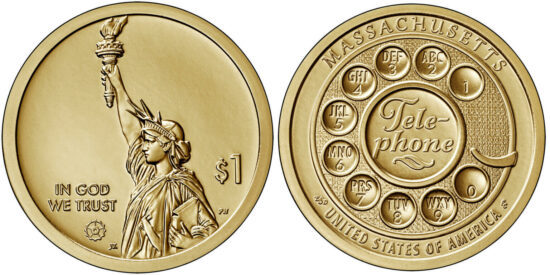
Since 2021, dollar coins have also depicted changing motifs, featuring great inventions of the federal states. Here you can see Massachusetts boasting about the invention of the telephone.
A New Variety
As mentioned above, the 50 State Quarter series was a huge success for the US Mint. According to a press release, about 140 million Americans are said to have collected them. Due to the series’ popularity, the mint abandoned the original plan to put the eagle back on the reverse after 2008. Instead, the proven concept was continued. At first, in addition to the 50 State Quarters, one quarter each was dedicated to Washington DC (no federal state, just a district) and to the five US overseas territories in 2009. Subsequently, the America the Beautiful quarter series was issued from 2010 to 2021. It was kind of a continuation of the 50 State Quarter series depicting national parks and historic sites of the federal states. Since 2022, important women in US history have been depicted on quarters. And the dollar coin has also featured changing motifs since 2018 with the American Innovation programme. Although the public interest and the demand have much decreased since the original 50 States Quarters were issued: US coins have never been as diverse and “collectible” as they are today.
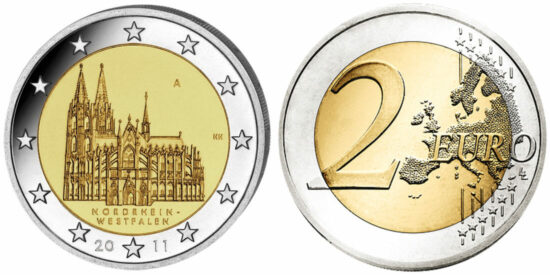
Following the example of the 50 State Quarter series, Germany depicted its 16 states on 2 euro coins. You can see here: Cologne Cathedral for North Rhine-Westphalia. Image: Emporium Hamburg / ECB.
The concept was also imitated abroad. Between 2006 and 2022, Germany issued 2 euro commemorative coins presenting one of its 16 federal states each year. Most of them featured a castle, a palace or a church. This programme will be continued as well: from 2023 to 2038, the series will be repeated with new motifs. Japan also started a similar series and issued 500 yen commemorative circulation coins for each of the 47 prefectures from 2008 to 2016.
Renaissance
At a time, when the coin trade and coin collecting in general were in crisis, the 50 State Quarter series filled a new generation of Americans with enthusiasm for coin collecting by rewarding them for taking a close look at their change. Almost at the same time, a similar phenomenon emerged here in Europe as coins from all euro countries began to circulate after the introduction of the euro. All of a sudden, Europeans too were looking for rare (foreign) pieces in their change to fill up their coin albums. Due to these two developments, the time around 2000 can certainly be referred to as a renaissance for the hobby of coin collecting, which was suddenly much more present than in previous decades and reached larger parts of the population. In retrospect, we must certainly congratulate the initiators around the then Mint Director Philip Diehl for a successful project that revitalised the hobby and brought it to a new generation.
All 50 State Quarters and the District of Columbia and US Territories Quarters can be found at Cosmos of Collectibles.
Harvey Stack is considered a key figure behind the idea of the 50 State Quarters. He passed away on 3 January 2022. Here you can read the obituary by Ursula Kampmann.
We presented the history and the work of the US Mints in Philadelphia, Denver, San Francisco and West Point in several articles.






